stop start AUDI R8 SPYDER 2014 User Guide
[x] Cancel search | Manufacturer: AUDI, Model Year: 2014, Model line: R8 SPYDER, Model: AUDI R8 SPYDER 2014Pages: 244, PDF Size: 61.06 MB
Page 71 of 244
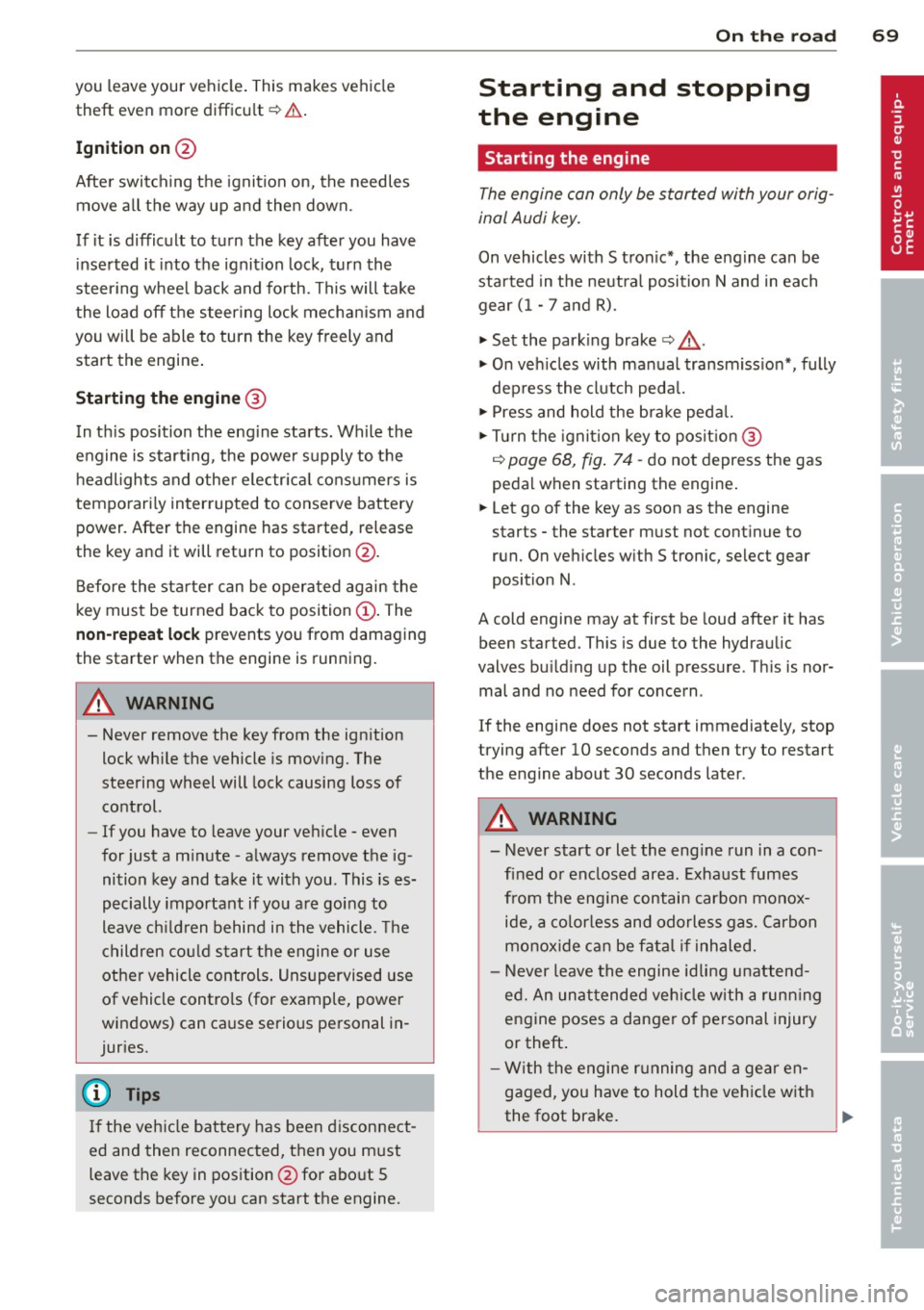
you leave your vehicle. This makes vehicle
theft even more difficu lt
r=:, .&. .
Ign ition on @
After switch ing the ignition on, the needles
move all the way up and then down.
If it is difficult to turn the key after you have inserted it into the ignit ion lock, turn the
steer ing whee l back and forth. This will take
the load
off the steering lock mechan ism and
you will be able to turn the key freely and start the engine .
Starting the engine @
In th is position the engine starts. While the
engine is start ing, the power supply to the
headlights and other e lectr ica l cons umers is
temporari ly inter rupted to conserve battery
power. After the engine has started, release
the key and it will return to position @.
Before the starter can be operated again the
key must be turned back to position
(D . The
non-repeat lock prevents you from damaging
the starter when the engine is running.
A WARNING
- Never remove the key from the ign ition
lock while the vehicle is moving. The
steering wheel will lock causing loss of
control.
- If you have to leave your veh icle - even
for just a m inute - a lways remove the ig
nition key and take it with you. This is es
pecially important if you a re going to
leave ch ildren behind i n the vehicle. The
children co uld s tart the engine or use
other vehicle controls . Unsupervised use
of vehicle controls (for example, power
windows) can cause serious personal in
juries.
@ Tips
I f the veh icle bat tery has been d isconnect
ed and then reconnected, then you must
leave the key in pos ition @for abo ut 5
seconds before you can start the engine.
-
On th e ro ad 69
Starting and stopping
the engine
Starting the engine
The engine can only be started with your orig
inal Audi key.
On vehicles with S tron ic*, the e ngine can be
sta rted in the neut ra l position N and in each
gear (1 - 7 a nd R).
" Set the park ing brake
r=:, & .
"On veh icles with manual transmiss ion*, fully
dep ress the clutch peda l.
" Press and hold the brake peda l.
" Tur n the igni tion key to pos it ion @
r=:> page 68, fig . 74 -do not depress the gas
peda l when sta rting the engine .
... Let go of the key as soon as the engine
starts - the starter m ust not cont inue to
run. On vehicles w ith S tronic, select gear
position N.
A cold engine may at first be loud after it has
been started. This is due to the hydraulic
valves bu ild ing up the oil p ressure . Th is is nor
mal and no need for concern .
If the engine does not start immediately, stop
trying after 10 seconds and then try to restart
the engine about 30 seconds later .
A WARNING
- Never start or let the engine run in a con
fined or enclosed area. Exhaust fumes
from the eng ine contain carbon mono x
ide, a co lor less and odorles s gas. Carbon
monox ide can be fata l if inh aled.
- Never leave the engine id ling una ttend
ed. An unat tended ve hicle with a runn ing
engine poses a danger of personal injury
or theft .
- With the engine r unning and a gear en
gaged, you have to hold the veh icle w ith
the foot bra ke.
Page 72 of 244

70 On the road
(D Note
-Avoid hig h engine speeds, fast accelera
tion or heavy engine loads while the en
gine is still cold. Th is could damage the
engine.
- The engine cannot be started by pushing or towing the vehicle.
@) For the sake of the environment
To avoid unnecessary engine wear and to
reduce exhaust emissions, do not let your
veh icle stand and warm up. Be ready to
drive off immediately after starting your
veh icle.
Stopping the engine
On vehicles w ith S tronic*, the engine can be
turned off in the neutral position N and in
each gear (1 -7 and R).
~ Turn the ign ition key to position ©
r:::>page 68, fig . 74 .
_& WARNING
- Never turn off the engine until the vehi
cle has come to a complete stop.
- Th e brake booster and servotronic on ly
work when the engine is running. With
the ignition turned off, you have to apply
more force when steering or braking .
Since you cannot steer and stop norma l
ly, this can lead to accidents and serious
injuries.
(D Note
- If the engine has been under heavy load
for an extended period of time, heat
builds up in the engine compartment af
ter the engine is switched off -there is a
risk of damaging the engine. Allow the
engine to continue to run at idle for a
short time or drive until it has cooled
down before you turn it off¢
page 75.
- If the engine has been under heavy load
for an extended period of time, it can be
come extremely hot. You should not park your vehicle over easily combustib
le ob
jects or areas (e .g. grass or leaves). There
is a risk of starting a fire.
(D Tips
After the engine has been switched off, the
radiator fan can continue to run for up to
10 minutes -even with the ignition switch
ed off. It can also sw itch on again after
some time if the coolant temperature rises
as the result of heat buildup or if the en
gine compartment is heated by the sun's
rays and the engine is hot.
Parking brake
Parking brake
When the parking brake is set, it prevents the
vehicle from rolling away unintentionally
Fig. 75 Center co nsole : Parking brake set
Sett ing the parking brake
~ Pull the parking brake lever all the way up.
Releasing the parking brake
~ Pull the parking brake lever up slight ly and
press the release button at the same time
r:::>fig. 75-arrow- .
~ Keep the release button pressed and lower
the park ing brake ¢,& .
If you shou ld drive off with the parking brake
still set, a warning tone will sound and the
following message will appear in the instru
ment cluster to remind you to release the
parking brake:
Handbrake is applied
Page 73 of 244
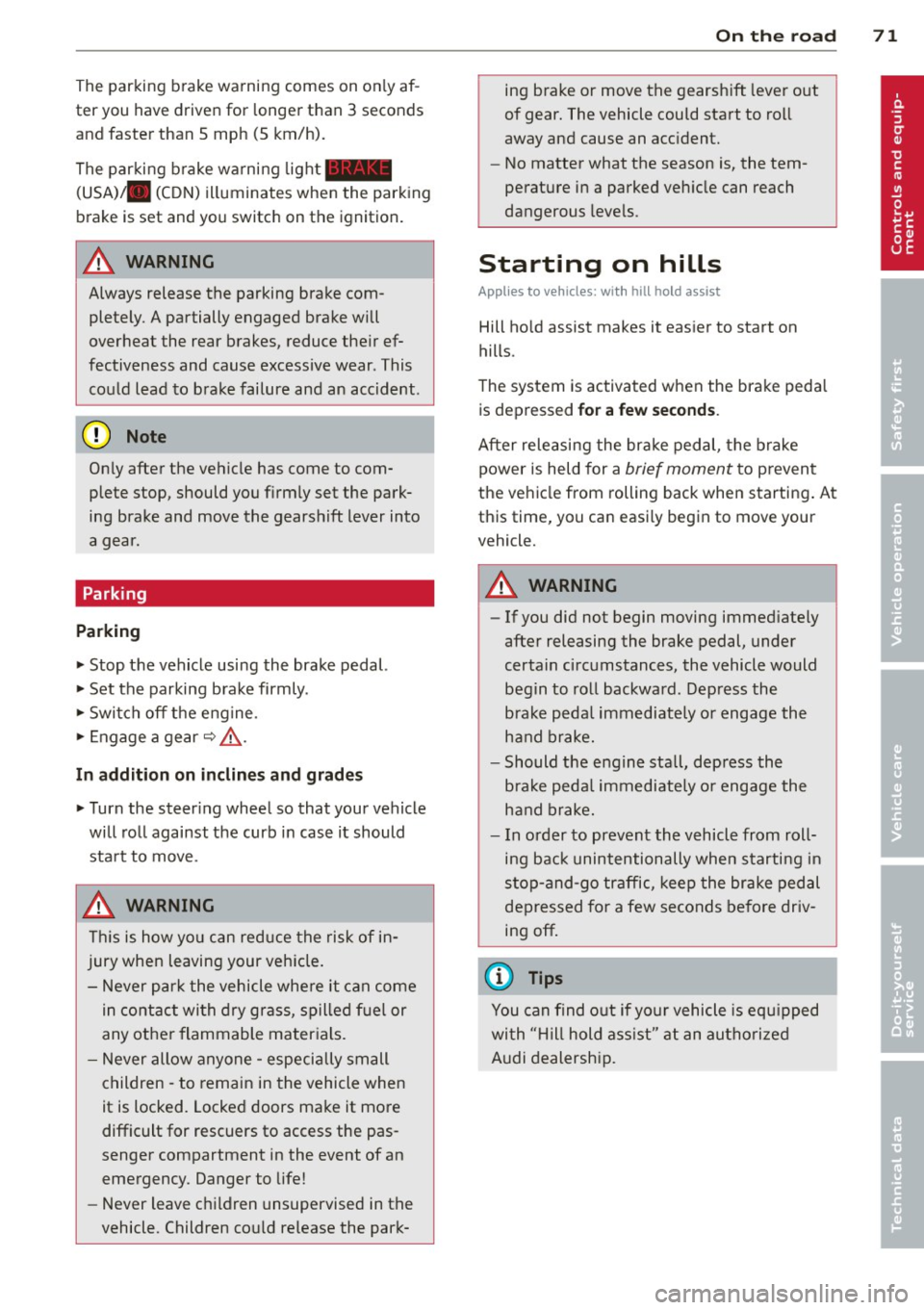
The parking brake warning comes on only af
ter you hav e drive n for longer than 3 seconds
and faster than 5 mph (5 km/h).
The parking b rake warning light _
(USA)/ . (CON) illuminates when the parking
brake is set and you switc h on the ignition .
A WARNING
Always release the parking brake com
pletely. A partially engaged brake will
overheat the rear brakes, reduce the ir ef
fectiveness and cause excess ive wear . This
could lead to brake failure and an accident .
On ly after the vehicle has come to com
plete stop, should you f irm ly set the park
ing brake and move the gearshift lever into
a gear.
Parking
Parking
"' Stop the vehicle using the brake pedal.
"' Set the parking brake firmly.
"' Swi tch off the e ngine .
"' Engage a gear
~ ,&. .
In addition on inclines and grad es
"' Turn the steer ing whee l so that your vehicle
will ro ll against the curb i n case it should
sta rt to move .
A WARNING
This is how yo u can reduce the risk of in
jury when leaving your veh icle.
- Never pa rk the vehicle whe re it can come
in contac t wi th dry grass, spille d fu el or
any othe r flammable materials.
- Never allow a nyone - especially small
children -to remain in the vehicle when
it is locked. Locked doors ma ke it mo re
difficult for rescuers to access the pas
senger compartment in the event of an emergency . Danger to life!
- Never leave c hildren unsupervised in the
vehicle . Children co uld re lease the park-
-
On th e ro ad 71
ing brake or move the gearsh ift leve r out
of gear. The vehicle could start to ro ll
away and cause an acc ident.
- No matter what the season is, the tem
perature in a parked ve hicle can reach
dangerous leve ls.
Starting on hills
App lies to vehicles : wi th hill ho ld assist
Hill ho ld assist makes it eas ier to start on
hill s.
The system is activated when the brake peda l
is depressed
for a few second s.
After releasing the brake ped al, the brake
power is held for a
brief moment t o p reven t
the ve hicle from rolling back when starting . A t
this time, you can easi ly begin to move your
vehicle.
A WARNING
- If you did not begin moving immed iate ly
after releasing the brake pedal, under
certa in circumstances, the vehicle would
begin to roll backwa rd . Dep ress the
brake peda l imm ediate ly o r engage the
hand b rake.
- Should t he eng in e sta ll, dep ress th e
bra ke peda l immediate ly o r engage the
ha nd br ake.
- In o rder to prevent the vehicl e from roll
ing back unintentionally whe n starti ng in
s top-and-go tr affic, keep the br ake ped al
depressed fo r a few seconds be fore driv
in g off .
(D Tips
You can find o ut if yo ur vehicle is equ ipped
wi th "Hi ll hold ass ist" at a n au thori ze d
A udi dealersh ip.
Page 79 of 244
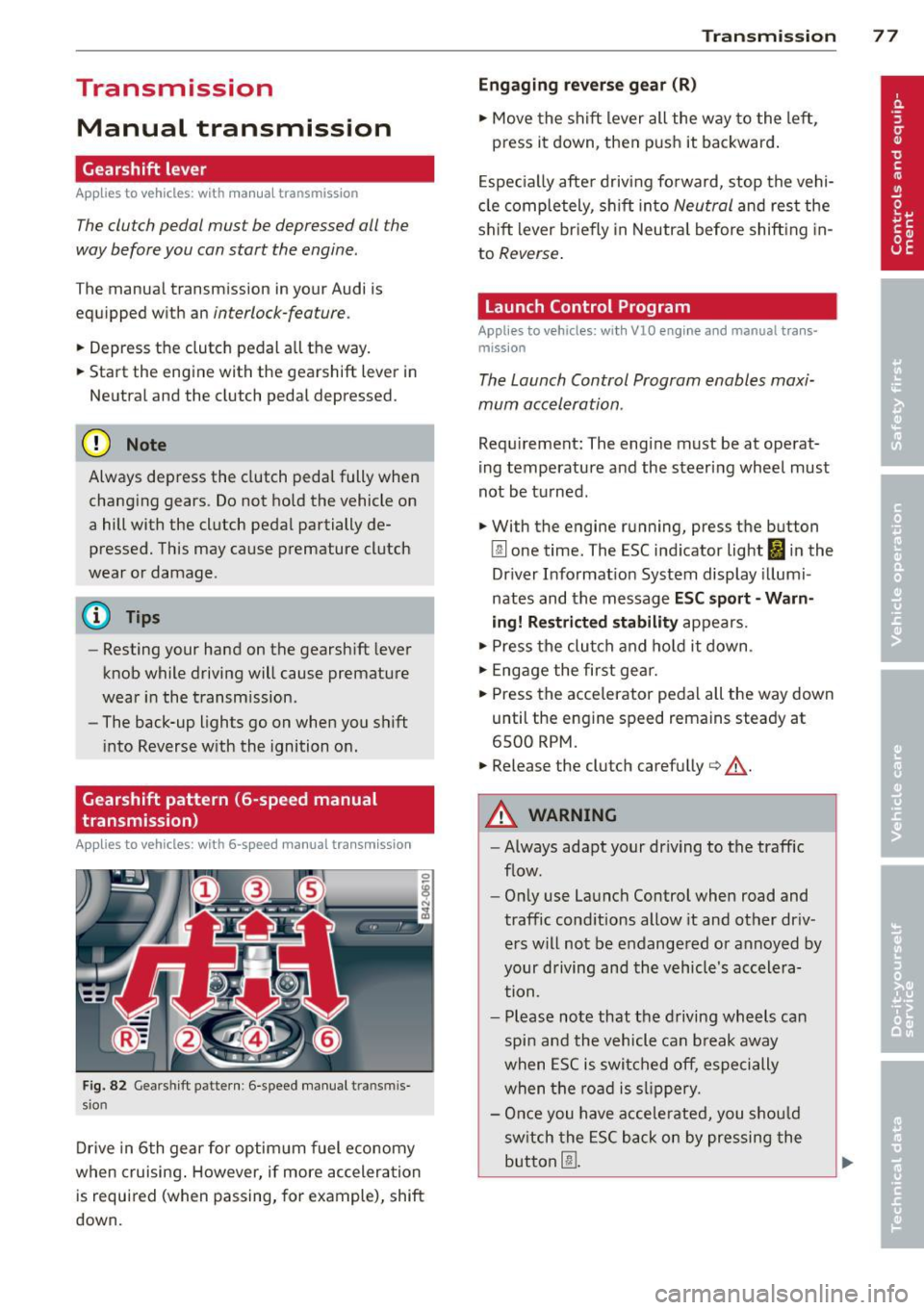
Transmission Manual transmission
Gearshift lever
App lies to vehicles: with manual transmission
The clutch pedal must be depressed all the
way before you can start the engine.
The manual transmission in your Audi is
equipped with an
interlock-feature.
• Depress the clutch pedal all the way.
• Start the engine with the gearshift lever in
Neutral and the clutch pedal depressed.
(D Note
Always depress the clutch pedal fully when
changing gears . Do not hold the vehicle on
a hill with the clutch pedal partially de
pressed. This may cause premature clutch
wear or damage .
@ Tips
-Resting your hand on the gearshift lever
knob while driving will cause premature
wear in the transmission.
- The back-up lights go on when you shift
into Reverse w ith the ignition on.
Gearshift pattern (6-speed manual
transmission)
Applies to vehicles: with 6-speed manual transmission
Fig. 82 Gears hift patte rn: 6 -speed manual tran smis
sion
Drive in 6th gear for optim um fuel economy
when cruising . However, if more acceleration
is required (when passing, for example), shift
down.
Transmission 77
Engaging reverse gear (R)
• Move the shift lever all the way to the left,
press it down , then push it backward.
Especially after driving forward, stop the vehi
cle completely, sh ift into
Neutral and rest the
shift lever br iefly in Neutra l before shift ing in
to
Reverse .
Launch Control Program
Applies to vehicles: with VlO eng ine and manual t ra ns·
miss ion
The Launch Control Program enables maxi
mum acceleration .
Requirement: The engine must be at operat
ing temperature and the steering wheel must
not be turned .
• With the engine running, press the button
[g] one time. The ESC indicator light I in the
Driver Informat ion System display illumi
nates and the message
ESC sport - Warn
ing! Restricted stability
appears.
• Press the clutch and hold it down .
• Engage the first gear.
• Press the accelerator pedal all the way down
until the engine speed remains steady at
6500 RPM.
• Release the clutch carefully¢.&, .
A WARNING
-Always adapt your dr iving to the traffic
flow.
- Only use Launch Control when road and
traffic conditions allow it and other dr iv
ers will not be endangered or annoyed by
your driving and the vehicle's accelera
tion .
- Please note that the driving wheels can
spin and the vehicle can break away
when ESC is switched off, especially
when the road is slippery.
- Once you have accelerated, you sho uld
sw itch the ESC back on by pressing the
button @.
Page 81 of 244
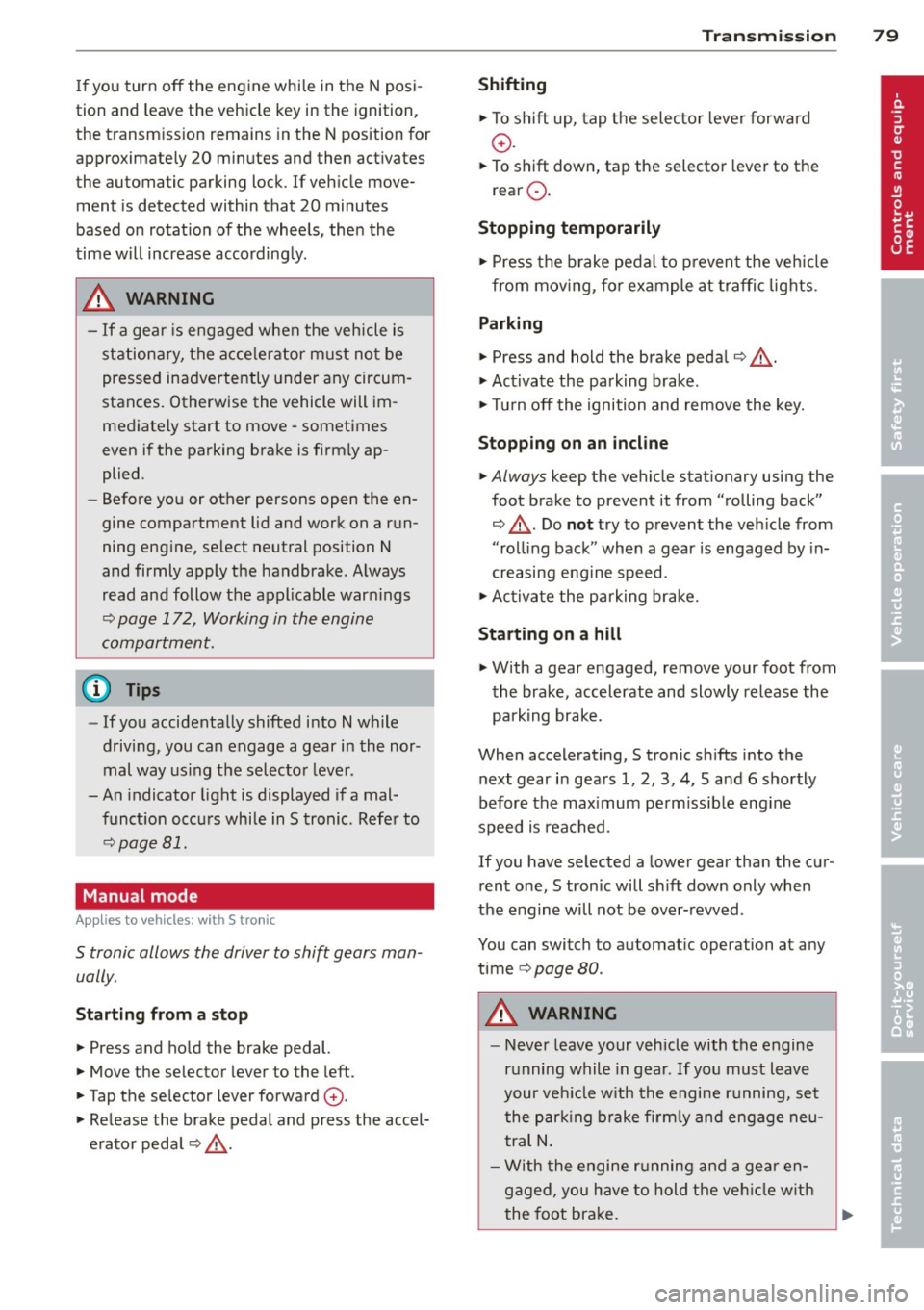
If you turn off the engine while in the N posi
ti on and leave the vehicle key in the ignition,
the transm ission remains in the N pos ition for
approximately 20 mi nutes an d then act ivates
th e automatic parking lock. If vehicle
move
ment is detected within tha t 20 minutes
based on rotat ion of the wh eels, th en the
time will increas e according ly.
A WARNING
- If a gear is engaged when the vehicle is
stationa ry, the acce lerator must not be
pressed inadvertently under any circum
stances. Otherwise the vehicle will im
med iately start to
move -sometimes
even if the parking brake is firmly ap
plied.
- Before you or other persons open the en
gine compartment lid and work on a ru n
ning eng ine, se lect neutral position
N
and firmly apply the handbrake. A lways
read and follow the applicable warn ings
¢ page 172, Working in the engine
compartment.
(i) Tips
- If you accidentally shifted into N while
driving, you can engage a gear in the nor mal way using the selecto r lever.
-An indicator light is displayed if a mal
funct ion occ urs while in S tronic. Refe r to
qpage 81.
Manual mode
Appl ies to vehicles : wit h S t ronic
S tronic allows the driver to shift gears man
ually.
Starting from a stop
.. Press and ho ld the brake pedal.
.. Move the selector lever to the left.
.,. Tap the selector lever forward
0 -
.. Re lease the brake pedal and press the accel
erato r peda l¢ ,& .
Tran sm iss ion 79
Shifting
.,. To shift up, tap the selec to r l ever forwa rd
0-
.. To shift down, tap the selector lever to the
rear Q.
Stopping temporarily
.. Press the b rake pedal to p revent the veh icle
from mov ing, fo r ex ample at tra ffic l ights.
Parking
.. Press and hold the brake pedal¢ ,& .
.. Act ivate the park ing brake .
.,. Tu rn off the ignition and remove the key.
Stopping on an incline
.. Always keep th e vehicle stat ionary using the
foot brake to prevent it from "rolling back"
¢ ,& . D o
not try to p revent the veh icle from
"rol ling back" when a gear is engaged by in
creasing e ng ine speed.
.. Ac tiva te the pa rk ing br ake.
Starting on a hill
.. With a gear engaged, remove your foot from
th e brake, accelerate and slowly release the
park ing brake.
When accelerat ing, S tronic sh ifts i nto the
next gear i n gears 1, 2, 3, 4, 5 and 6 shortly
before the max imum pe rm issib le eng ine
speed is reached.
If you have se lected a lowe r gear tha n the cur
r ent one, S tron ic will s hift down only when
the engine will not be
over- revved .
You can switch to automat ic operation at any
time
q page 80.
A WARNING
-Never leave your vehicle with the engine
ru nning while in gear . If you must leave
your veh icle w ith the engine r unning, set
the par king brake firm ly and engage neu
tral
N.
- W ith the engine r unning and a gear en
g aged, you have to hold the ve hicle with
the foot bra ke.
Page 82 of 244
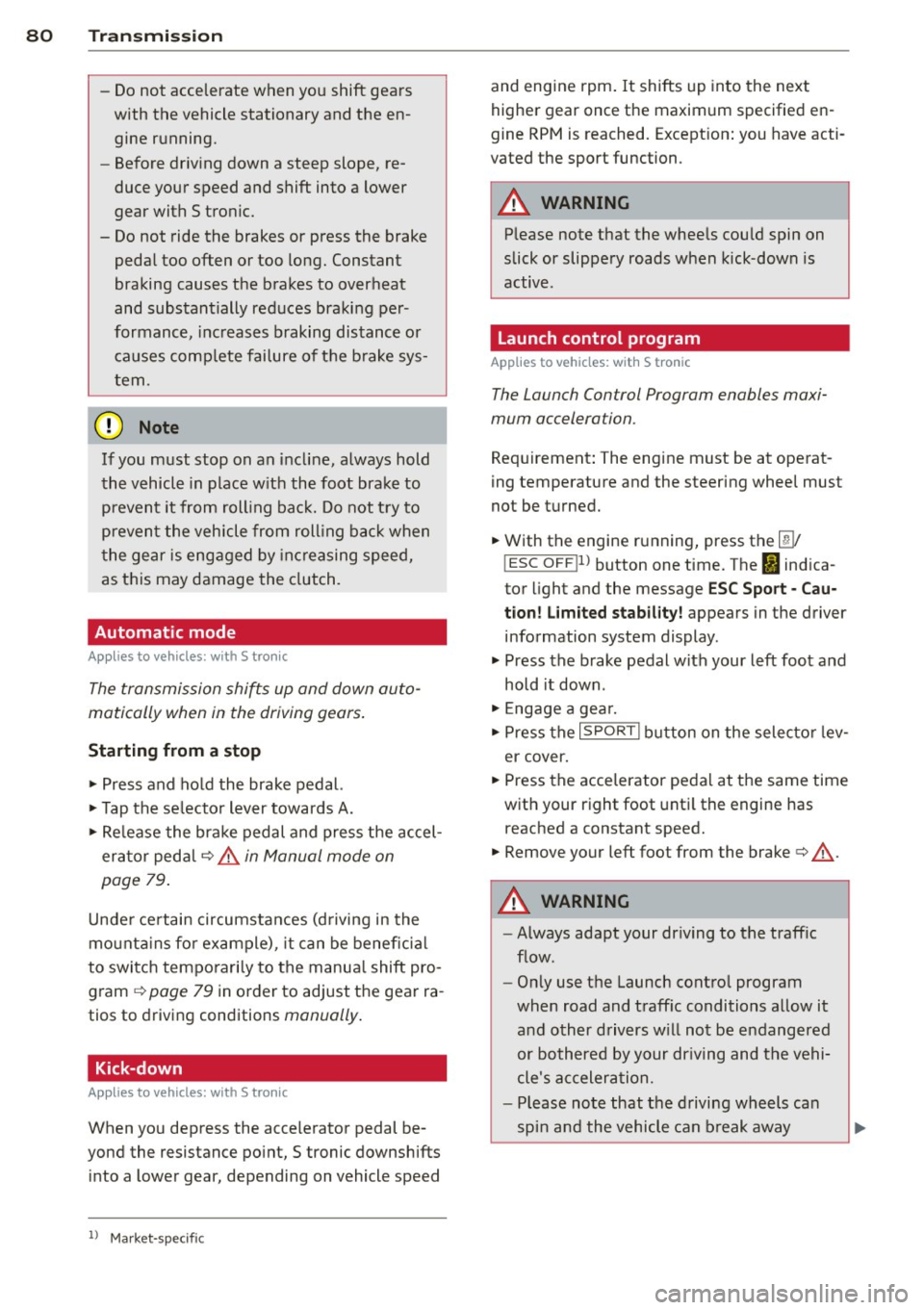
80 Transmi ssion
-Do not accelerate when you shift gears
with the vehicle stationary and the en
gine running.
- Before driving down a steep slope, re
duce your speed and shift into a lower
gear with S tron ic.
- Do not ride the brakes or press the brake pedal too often or too long. Constant
braking causes the brakes to overheat
and substantially reduces brak ing per
formance, inc reases braking distance or
c auses comp lete failure of t he b rake sys
tem.
0 Note
If you must stop on an incline, always hold
t he vehicle in place w it h the foot bra ke to
p revent it from roll ing ba ck. Do not t ry to
preven t the vehicle from r oll ing bac k when
t he ge ar is engaged by increasing speed,
as t his may damage the clutch .
Automatic mode
Applies to vehicles: with 5 tronic
The transmission shifts up and down auto
matically when in the driving gears.
Starting from a stop
.. Press and hold the brake peda l.
.. Tap the se lector lever towards A.
.. Re lease the brake pedal and press the accel
era to r peda l¢
A in Manual mode on
page
79 .
Unde r certain circumstances (d riving in the
mo unt ains fo r example), it can be beneficia l
to switch tempo rari ly to the manua l shift pro
gram ¢
page 79 in order to adjust the gear ra
tios to driving conditions
manually .
Kick-down
Applies to vehicles: with S tronic
When you depress the acce lerator pedal be
yond the resistance po int, S tronic downshifts
i n to a lower gear , depending on vehicle speed
l) Market- sp ec ifi c
and engine rpm . It shifts up into the next
higher g ear once the maximum specified en
gine RPM is reached. Except ion: you have acti
vated the sport func tion .
A WARNING
Please note that the whee ls cou ld spin on
slick or slippe ry roads when kick-down is
active .
Launch control program
Applies to vehicles: wit h S tronic
The Launch Con trol Program enables maxi
mum acceleration .
Requirement: The eng ine must be at operat
ing temperature and the steering wheel must
not be turned.
.. With th e engine running, press the
(fill
!ESC OFF!1l
button one time. The I ind ica
tor light and the message
ESC Spo rt -Cau
tion! Lim ited stabil ity!
appears in the driver
information system display .
.. Press the brake pedal with your left foot a nd
hold it down .
.. Engage a gea r.
.. Press the
I SPOR T! button on the selecto r lev
er cover .
.. Press the accelerator peda l at the same time
with your right foot unti l the engine has
reached a constant speed .
.. Remove your left foot from the brake¢,&. .
A WARNING
--Always adapt your dr iving to the traff ic
f low.
- Onl y use t he Launch contro l program
when road and t raff ic conditions a llow it
a nd other d rivers w ill not be e ndangered
or both ered by your dr iving and the vehi
cle 's ac celera tion.
- Pl ease note that the d riving wheels ca n
sp in a nd the vehicle can b reak away
-
Page 90 of 244
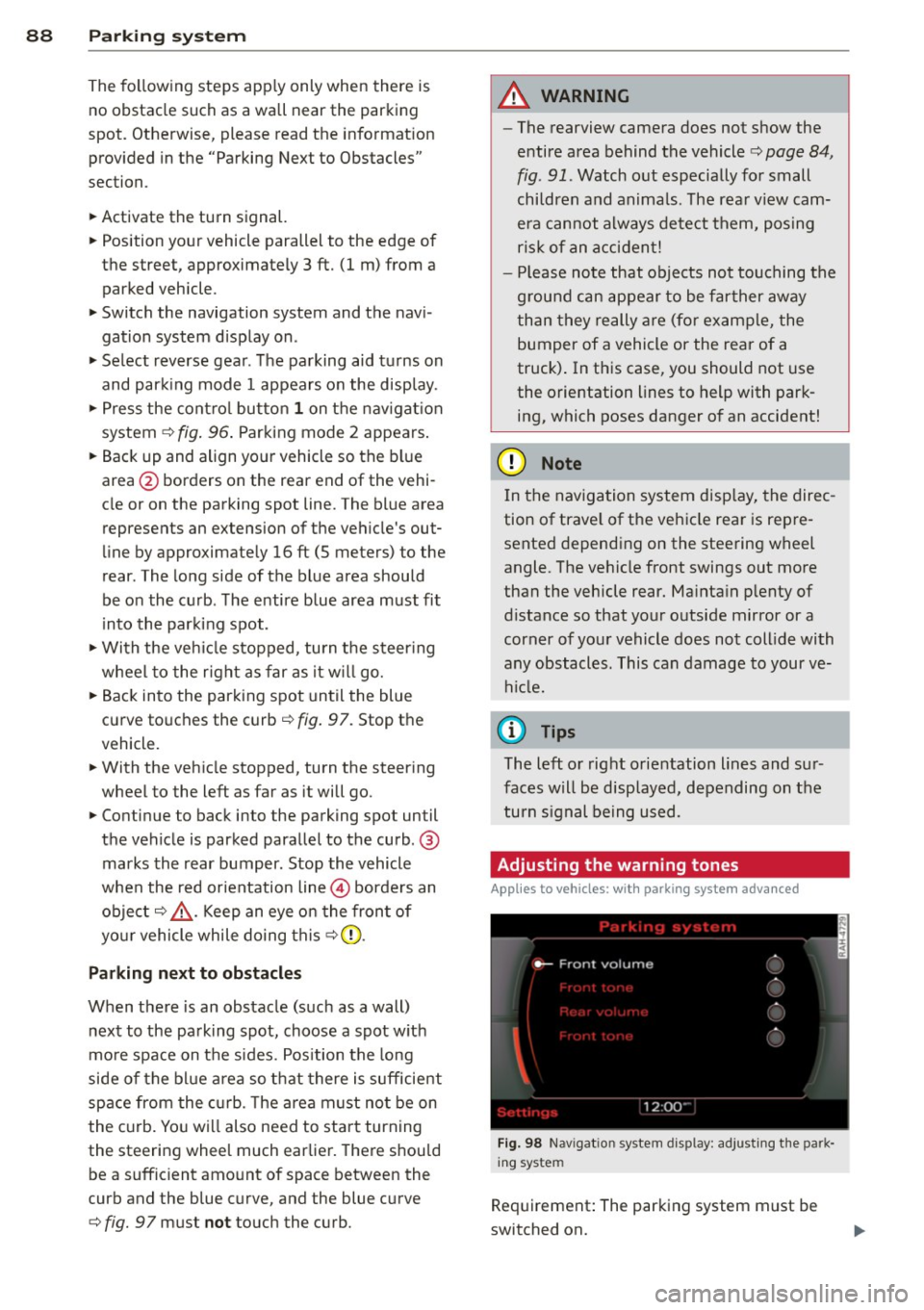
88 Parking system
The following steps app ly only when there is
no obstacle such as a wall near the parking
spot. Otherwise, please read the informat ion
prov ided in the "Parking Next to Obstacles"
section.
.. Activate the turn signal.
.. Position yo ur vehicle parallel to the edge of
the street, approximately 3 ft. (1 m) from a parked vehicle .
.. Switch the navigation system and the nav i
gat ion system d isplay on.
.. Se lect reverse gea r. The parking aid turns on
and park ing mode 1 appears on the disp lay.
.. Press the contro l bu tton
1 on the nav igat ion
system
r=> fig. 96 . Parking mode 2 appears .
.. Back up and align yo ur vehicle so the blue
area @ borders on the rear end of the vehi
cle or on the parking spot line. The bl ue area
represents an extension of the veh icle's out
li ne by approximate ly 16 ft (5 meters) to the
rear . The long side of the blue area should
be o n the cu rb. The entire blue area must fit
into the parking spot .
.. With the veh icle stopped, turn the s teer ing
wheel to the right as far as it w ill go.
.. Back into the par king spot until the blue
c ur ve to uches the curb
r=> fig. 97. Stop the
vehicle.
.. With the veh icle stopped, turn the steer ing
wheel to the left as far as it will go.
.. Co ntinue to back into the parking spot un til
the veh icle is parked para llel to the curb .@
marks the rear bumper . Stop the vehicle
when the red orientation line@ borders an
obje ct
r=> & -Keep an eye on the front of
yo ur vehicle while doing this
r=>0 .
Parking n ext to obstacles
When t here is an obstacle (such as a wall)
next to the pa rk ing spot, choose a spot w ith
mo re space on t he sides. Pos ition the long
side of the blue area so that there is sufficie nt
sp ace from the curb. The area m ust no t be on
the c urb. Yo u will also need to start turning
the steering wheel much earlier. There should
be a suffic ient amo unt of space between the
curb and the b lue curve, and the blue c urve
¢
fig. 97 must not to uch the curb.
A WARNING
- The rearview camera does not show the
entire area behind the vehicle¢ page
84 ,
fig . 91 . Watch out especially for small
children and anima ls . T he rea r view cam
era cannot always de te ct them, pos ing
r is k of an a ccide nt!
- P lease note that objects not touching the
g round can appear to be far ther away
t han they really are (for examp le, the
bumper of a vehicle or the rear of a
truck) . In this case, you should not use
the orientation lines to help with par k
ing, which poses danger of an accident!
(D Note
In the navigation system d isp lay, the direc
tion of trave l of the vehicle rear is rep re
sented depending on the stee ring wheel
angle. The vehicle front swings out more
than the vehicle rear. Ma inta in p lenty of
distance s o that your outside mirror or a
corner of you r vehicle does not coll ide wi th
any obstacles. This can damage to your ve h icl e .
(D Tips
The left o r right orie ntation lines and su r
faces will be disp layed, depending on t he
tu rn s ignal being used .
Adjusting the warning tones
Applies to vehicles: with parking system advanced
Fig . 98 Nav igat io n s ystem d is pl ay: adj ust ing the park
i ng sys te m
Req uirement : The parking system must be
switched on.
Page 92 of 244
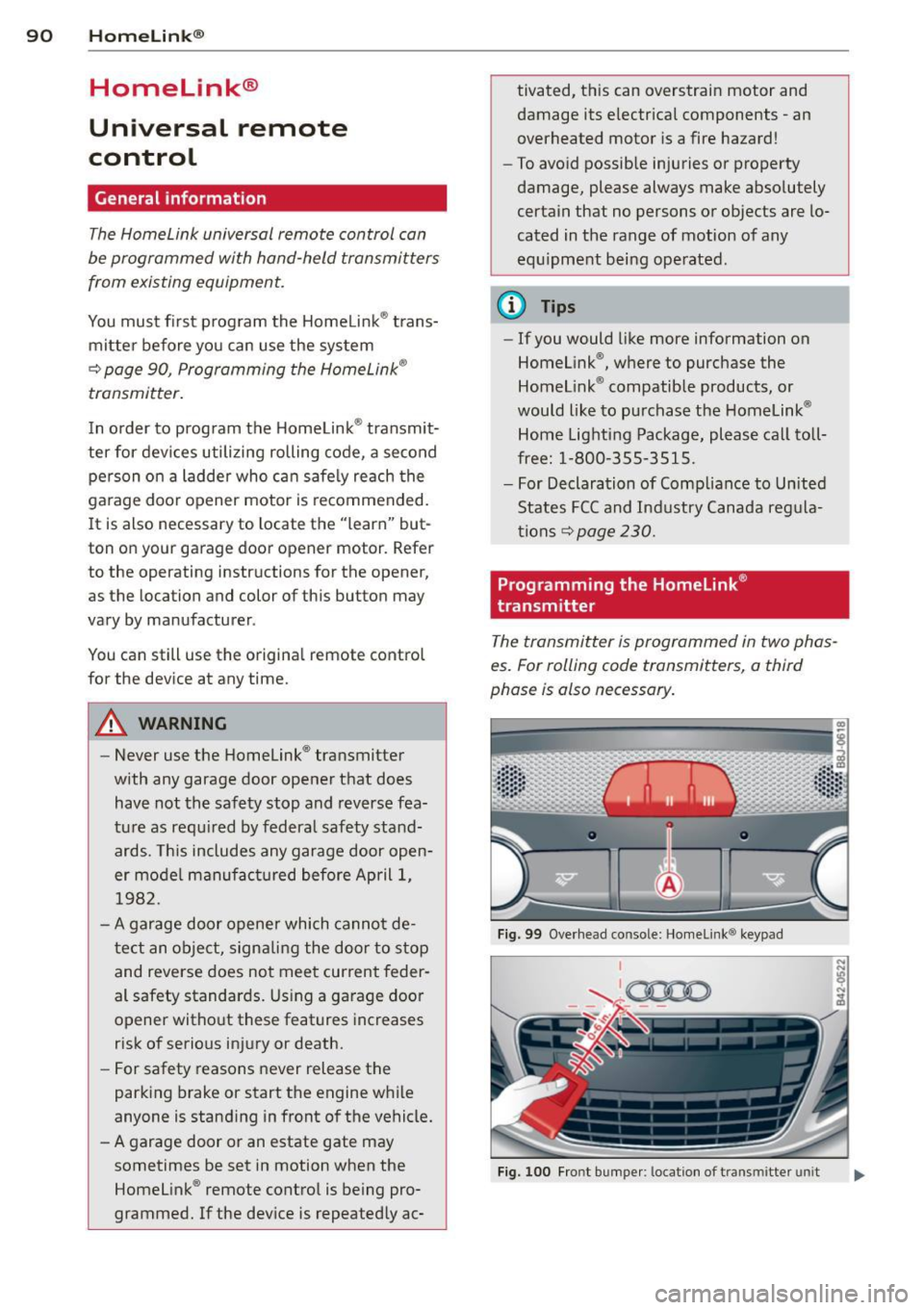
90 Homelink®
Homelink®
Universal remote
control
General information
The Homelink universal remote control can
be programmed with hand-held transmitters
from existing equipment.
You must first program the Homelink ® trans
mitter before you can use the system
~ page 90, Programming the Homelink ®
transmitter.
I n o rder to prog ram the Homelink ® transmit
ter for devices utilizing rolling code, a second pe rson on a ladder who can safely reach the
garage doo r opener motor is recommended.
It is also necessary to locate the "learn" but
ton on your garage door opener motor . Refer
to the operating instructions for the opener,
as the location and color of this button may
vary by manufacturer .
You can still use the original remote control
for the device at any time.
A WARNING
-
- Never use the Homelink® transmitter
with any garage door opener that does
have not the safety stop and reverse fea
ture as requ ired by federa l safety stand
ards. This includes any garage door open
er model manufactured before April 1,
1982.
- A garage door opener which cannot de
tect an object, signa ling the door to stop
and reverse does not meet current feder
al safety standards. Using a garage door
opener without these features increases
risk of serious injury or death.
- For safety reasons never release the
parking brake or start the engine while
anyone is stand ing in front of the vehicle.
- A garage door or an estate gate may
sometimes be set in motion when the
Homelink ® remote control is being pro
grammed. If the device is repeatedly ac- tivated, this can overstrain motor and
damage its e
lectrical components -an
overheated motor is a fire hazard!
- To avoid possib le injuries or property
damage, please always make absolutely
certain that no persons or objects are lo
cated in the range of motion of any
equ ipment being operated.
(!) Tips
- If you would like more information on
Homelink ®, where to purchase the
Homelink ® compatible products, or
would like to purchase the Homelink®
Home Lighting Package, please call toll
free: 1-800-355-3515.
- For Declaration of Compliance to United
States FCC and Industry Canada regula
tions~
page 230.
Programming the Homelink ®
transmitter
The transmitter is programmed in two phas
es. For rolling code transmitters, a third
phase is also necessary.
Fig. 99 Overhead co nsole: Homelink ® keypad
I
'-.. ~0000 - - ,r.;-_ - -
Fig. 100 Fro nt bumper : location of tra nsmi tter unit
Page 93 of 244
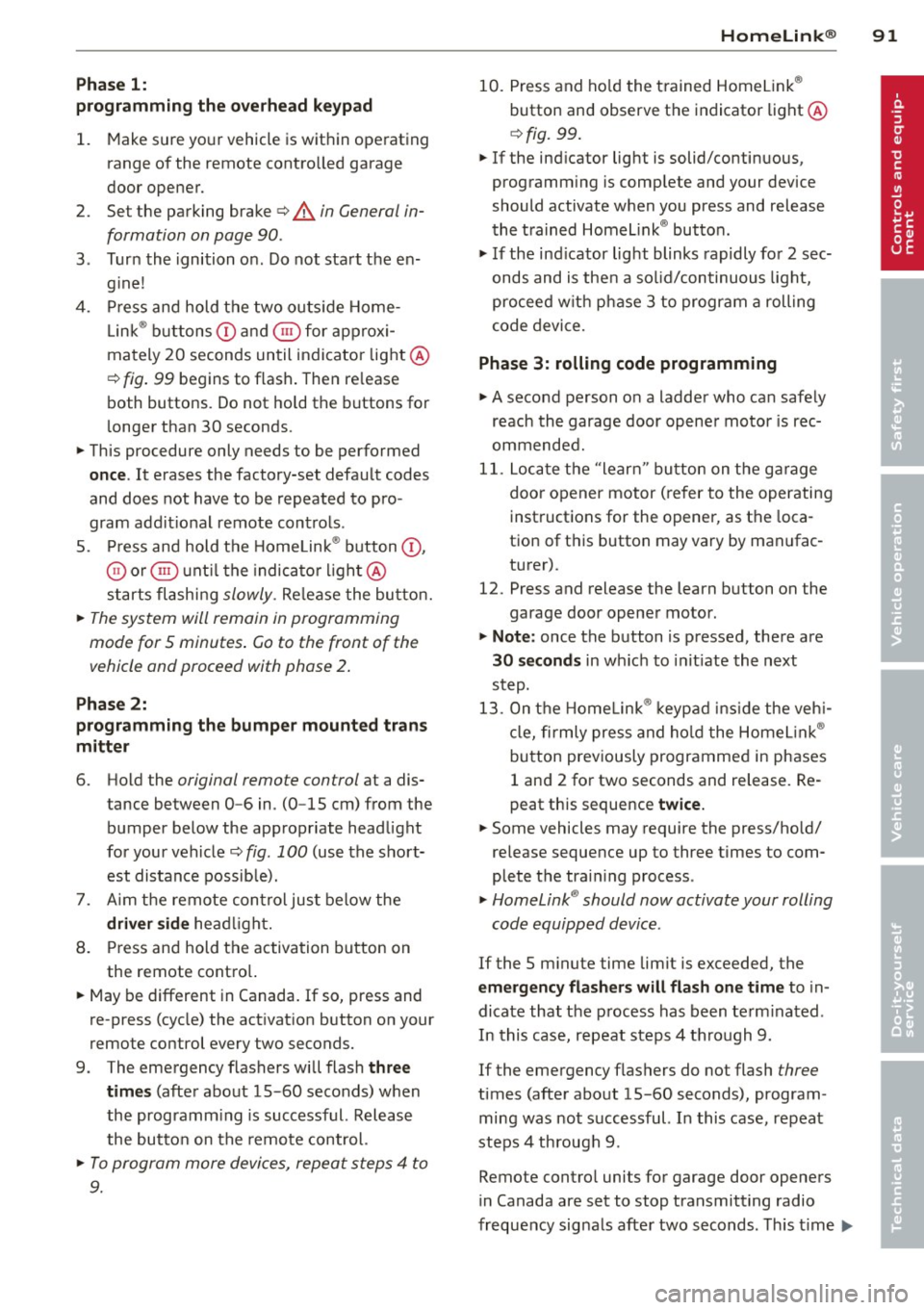
Phase 1:
p rogramming the overhead keypad
1. Make sure your vehicle is wit hin operating
range of the remote contro lled garage
door opener .
2. Set the parking brake
q A in General in
formation on page 90 .
3. Turn the ignition on . Do not start the en
gine!
4. Press and hold the two outs ide Home
Link ® buttons
(D and @for approxi
mately 20 seconds until indicator light@
c:!;> fig. 99 begins to flash. Then re lease
both buttons. Do not ho ld the buttons for
longer than 30 seconds .
.,. This procedure only needs to be performed
once . It erases the factory-set default codes
and does not have to be repeated to pro
gram addit ional remote controls .
S . Press and hold the Home Link ® button
(D ,
® or @ until the indicato r light @
starts flashing
slowly . Release the button.
.,. The system will remain in programming
mode for 5 minutes . Co to the front of the
vehicle and proceed with phase 2 .
Phase 2:
programming the bumper mounted trans
mitter
6. Hold the original remote control at a dis
tance between 0 -6 in . (0 -15 cm) from the
bumper below the appropriate headlight
for your vehicle
c:!;> fig. 100 (use the short
est distance possible).
7. A im the remote con trol just below the
driver side headlight.
8. Press and hold the activation button on
the remote control.
.,. May be different in Canada.
If so, press and
re-press (cycle) the act ivation button on your
remote control every two seconds.
9 . The emergency flashers will flash
three
times
(after about 15-60 seconds) when
the programm ing is successful. Release
the butto n on the remote control.
.,. To program more devices, repeat steps 4 to
9.
Homelin k® 91
10. Press and hold the trained Homelink ®
button and observe the indicator light @
qfig. 99.
.,. If the ind icator light is solid/continuous,
programm ing is complete and your device
should activate when you press and release
the trained Homelink ® button .
.,. If the ind icator light blinks rapidly for 2 sec
onds and is then a solid/continuous light,
proceed w ith phase 3 to program a rolling
code device.
Phase 3: rolling code programming
.,. A second person o n a ladder who can safely
reach the garage door opener motor is rec
ommended .
11. Locate the "learn" button on the gar age
door opener motor (re fer to the operating
instructions for the opener, as the loca
tion of t his button may vary by manufac
turer) .
12 . Press and release the learn button on the
garage door opener motor .
.,. Note : once the button is pressed, there are
30 seconds in which to initiate the next
step.
13. On the Home link® keypad inside the vehi
cl e, firmly press and hold the Homelink®
button prev iously programmed in phases
1 and 2 for two seconds and release . Re
peat this sequence
twice.
.,. Some vehicles may require the press/hold/
release sequence up to three times to com
plete the train ing process .
.,. Homelink ® should now activate your rolling
code equipped device.
If the 5 m inute time limit is exceeded, the
emergency flashers will flash one time to in
dicate that the process has been term inated .
In this case, repeat steps 4 through 9.
If the emergency flashers do not flash
three
times (after about lS-60 seconds), program
ming was not successful. In this case, repeat
steps 4 through 9 .
Remote contro l units for garage door openers
in Canada are set to stop transmitting radio
frequency signals after two seconds. This time ..,.
Page 160 of 244

158 Cleaning and protection
the waste water. In certain areas washing
a car outside of such facilities is not per
mitted.
Caring for vehicles with matte finish
paint
App lies to vehicles: with matte finish paint
Vehicles with ma tte finish poin t require spe
cial core due to the characteris tic s of the
point.
Automatic car washes
You must take the necessary precautions such
as closing the windows before using an auto
matic car wash. See the car wash attendant if
there is special equipment on your vehicle
such as a spoiler or remote control antenna
c:::> CD.
Only use car washes where the vehicle re mains stationary and the washing equipment
moves around the vehicle when washing and
drying .
It is not possible to use car washes
that move the vehicle through the car wash
using a chain
c:::> &,.
Only use car washes that use cloth cleaning
equipment, not brushes .
Washing with pressure washers
When washing your vehicles with a pressure
washer, always follow the operating instruc
tions provided with the pressure washer . This
is especially important in regard to the
pres
sure
and spraying distance. Be sure to keep
enough distance from soft materials such as rubber hoses or insulating material as well as
from the parking system sensors*, which are
located in the front or rear bumper.
Never use
rotary nozzles or high pressure
nozzles.
Washing by hand
T o avoid damaging the paint when washing,
first remove dust and large particles from
your vehicle. Insects , grease spots and finger
prints are best removed with a
special cleaner
for matte finish paint.
Apply the product using a microfiber cloth. To
avoid damaging the paint surface, do not use
too much pressure.
Rinse the vehicle thoroughly with water. Clean
the vehicle starting at the top and working to
ward the bottom using a
neutral shampoo
and a soft microfiber cloth. Stop frequently to
rinse the cloth thoroughly.
Clean the wheels and sill panels last. Use a
clean
sponge on these areas.
Rinse the vehicle thoroughly again and let it
air dry . If there are any water spots, they can
be removed using a
leather cloth.
Clean again with the special cleaner for matte
finish paint
if necessary .
Removing stubborn dirt
Bird droppings or tree sap
are best removed
with plenty of water and a microfiber cloth.
You should rinse off
gasoline residue immedi
ately with plenty of water .
A WARNING
--Wash your vehicle only when the ignition
is switched off to reduce the risk of a
crash .
- To reduce the risk of cutting yourself,
protect your hands and arms from metal
parts with sharp edges when cleaning
the underbody, the inside of the wheel
housings or the wheel covers.
- If washing your vehicle during the win
ter, moisture and ice in the brake system
can affect the vehicle's braking ability.
0 Note
-Do not treat vehicle parts painted with
matte finish paint using polishing mate
rials or hard wax. These products could
cause damage to the appearance or sur
face that cannot be repaired.
- Never use protective wax.
It can destroy
the matte finish effect.
- Do not place any stickers or magnetic
signs on vehicle parts painted with
matte finish paint. The paint could be